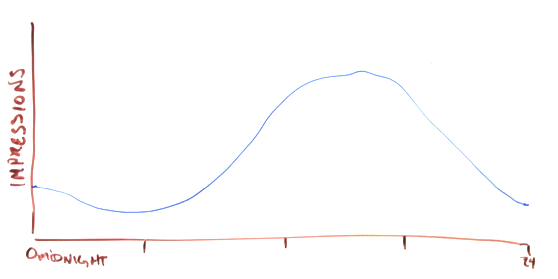This is the second part in a series on The Basics of Online Advertising. I’ll be posting a new entry each week for the next four or five weeks.
What are the Daily and Global Caps?
The Daily Cap is the limit of the number times an ad is shown throughout the day. With branded campaigns these are usually in the 10s or 100s of thousands. When used on a performance campaign it can vary based on the confidence in performance for the given targeting parameters. When the cap is achieved the ad stops serving. The next day the ad starts serving again until it reaches the daily cap once more.
The Global Cap is a bit of a misnomer. It behaves as the limiter for the entire campaigns impressions from beginning to end. Once the global the ad stops serving, period. It doesn’t start up again the next day. In ideal circumstances the global and daily cap are harmonious so that the daily cap was restrictive enough, but not overly restrictive such that the global cap was reached or nearly reached on the end date of the campaign. Mathematically speaking – an ideal daily cap is equal to the global cap divided by the number of days in the campaign.





 In a typical RTB transaction there’s a user ID, pulled from the user’s cookie or some form of server side system, which is passed to the DSP from the SSP. That ID is, in most cases, the DSPs record locator for the user’s information. Most DSPs have a server side data store where this information is housed, updated and augmented from a variety of sources including data companies like Blue Kai and Excelate and their ilk. DSPs may also be collecting and distilling information based on bid request activity from that user (although most SSPs put language into the contracts governing the use of this “bid stream” data) or retargeting data gathered for their customers. This type of data system is generally referred to as a Data Management Platform (DMP) in the industry. While there are some stand-alone DMPs out there, more and more DSPs are integrating or building their own.
In a typical RTB transaction there’s a user ID, pulled from the user’s cookie or some form of server side system, which is passed to the DSP from the SSP. That ID is, in most cases, the DSPs record locator for the user’s information. Most DSPs have a server side data store where this information is housed, updated and augmented from a variety of sources including data companies like Blue Kai and Excelate and their ilk. DSPs may also be collecting and distilling information based on bid request activity from that user (although most SSPs put language into the contracts governing the use of this “bid stream” data) or retargeting data gathered for their customers. This type of data system is generally referred to as a Data Management Platform (DMP) in the industry. While there are some stand-alone DMPs out there, more and more DSPs are integrating or building their own.
